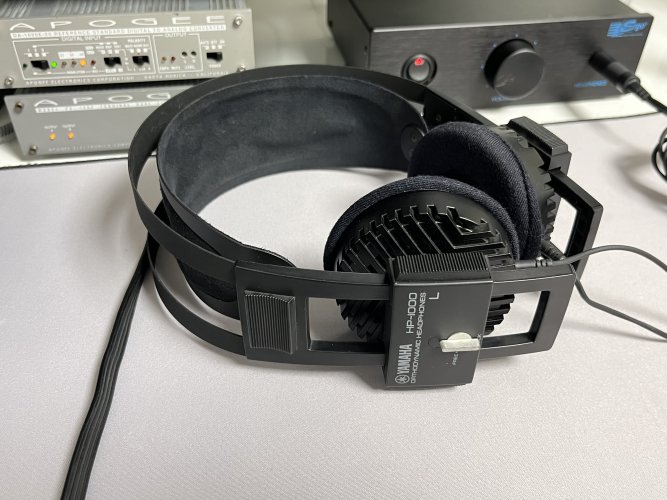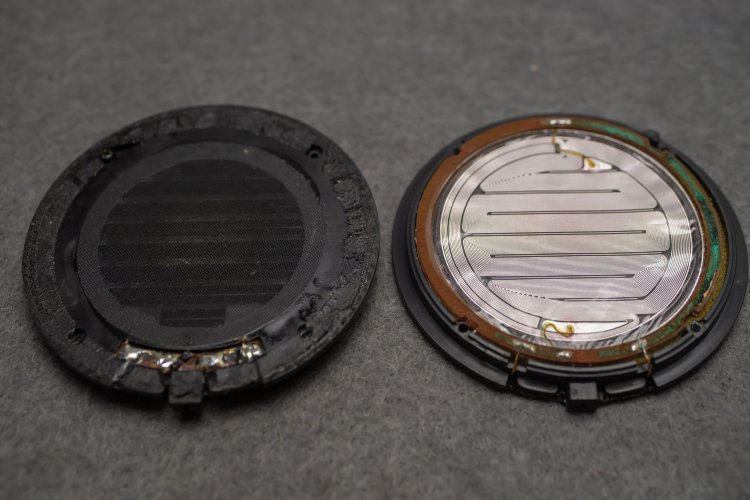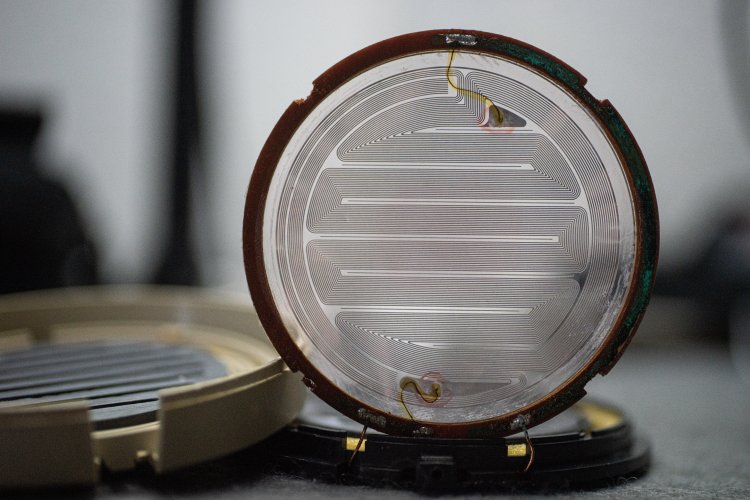Though I can mke my own cups, I don't have the skill to sew my own earpads though so HM5s aplenty until I learn how to I suppose. No convenient supply of spring steel either so it's fleabay headbands until I can figure out a way of getting a decent supply. Might just try that sony thing as a result and see what I can eke out of it as I've got a spare pair of Pro 30 drivers rattling about somewhere.
Most ortho drivers seem to sing when stuck in a more sympathetic enclosure, but driver surface area seems to really affect the sound even if it's just a bit. There's a big difference between the T10 and SFI-series drivers especially in the dynamic range from my experience
All I use nowadays is sorb, AC and sometimes AH, a bit of electrical tape or paper on the backside of the driver to increase treble and/or newplast if the situation calls for it honestly; everything else gives results that aren't worth the time required to perfect the sound imo. Wood enclosures don't need nearly as much extra damping work as plastic or metal either as they sound so darn good naturally when done right. The Bucket literally just has sorb squares on the back of the baffle and 0.2g of AH in each side, no felt or anything like that, and it already sounds very much satisfactory.
I've personally gotten stuck in the vintage receiver/speaker world now too oops. That's a whole new can of worms and as a result I haven't been spending nearly as much time on ortho damping schemes as I used to in the past. I should just marry my electronics, who neeeds girls anyways?!
What, a dynamic driver? Traitor! Witch! On to the stake he goes! //end hypocritical sarcasm
If you do go searching for a CD280 or CD380 I'll again recommend turning the pads inside out and swapping the left for the right and vice versa. This seals in the bass a little more, ime. While the cotton portions do allow bass to escape inside the pad, it's actually not horrible for the sound stage iirc; it's been a long time since my first franken phone, that was in like 2007. The baffles are pretty thick, tbh, and the kind of plastic they used doesn't sound too resonant to my ears either. I'll throw some sorb on them when I get the chance, but if this stuff is as magical as you're all saying my guess is I'll discover for myself what you all hear in a different enclosure. Just my gut feeling right now.
I'd definitely say driver surface area plays a key role in overall tonal quality, but there's too many variables going on for me to say just how exactly. The 55mm pinched ortho sounds very, very good to my ears, but, ceteris paribus, the difference between an aniso HP-1 and B&O U70 is night and day, imo, the U70 being to my favor. And I'd agree, there's a big difference between an SFI and a T10, from tonal quality to detail retrieval, to resonance frequency peak, and so on. They're just completely different animals, imo, especially when compared in their respective stock enclosures.
It's surprising how little needs to be done to get certain drivers to (arguably) sound flippin' fantastic, I'd agree.
My dad's got an old Sony receiver tucked away in the garage somewhere. I knew he was into Akai reel to reels, Audio Technica turntables, Koss Pro4AA's and the such when he was in college, but he failed to mention the -or I never listened close enough to him to hear he had a- "TOL" Sony receiver... He said he'd probably never sell it, he just doesn't know who could get any use out of it... I told him to go get it and that my F1000's could appreciate it! Still don't know where exactly that thing is or what kind of restoration might need to go into it, but if he's willing to part with it I'll find a corner for her, you can be sure. That or give the F1000's to my dad. He's not really a headphone guy anymore, and they'd for sure need a recable before gifting them to anyone, so who knows. If the ECR-Ortho ever gets finished I might just give him a pair of those? The F1000's are still rather novel, imo, so Idk. Maybe give him both or let him decide. If push comes to shove find a nice pair of Maggies for my dad, I'm sure he could get into that kind of thing. Not sure if his Sony has enough oomph for a pair of Maggies, tbh, though. I think he read me the specs and it gave out like 50wpc or something. Probably enough for him to enjoy his music a great deal, or maybe even get him bit by the audio bug all over again. Wonder what Mom will say about Maggies in the family room...
Ikr? Dynamics? I mean, honestly, who wastes their time with that crap? Oh yea, the F1000 is dynamic. Why'd AKG stop building those? Tooling was too expensive? Criminy... Seriously, the K1000's have detail rivaling anything I've heard to date, they're that good. I honestly think they'd sound phenomenally good with a sealed ear chamber, and proper ear-to-driver placement would probably be easier to achieve?
Quite frankly, those 38mm drivers will fit any AT knock-off cheapo woody so why bother with crappy plastic cups?
newplast works wonders to fit 38mm drivers into foster phones IME, easy as pie to apply, fully reversible and zero vibration whatsoever but I'll be sure to try sorb ASAP.
Wood sounds good, don't get me wrong, but what about the Lawton mods? That was basically laminating Dynamat over the entire insides of Mahogany driver enclosures, no? Granted, the wood cups on the D5000 are pretty thin and whatever wood they used is not very dense, imo. Doesn't surprise me Dynamat helped a great deal in that situation. I still think plastic can sound darn freaking good, though. Imagine crazy "lattice-type" driver housings printed with a 3D printer, too. Remember wualta saying something about infinitely variable damping enclosures? Building an enclosure that had variable acoustic mechanical damping built into the structure (think of a stringy kind of sponge where the lattice work restricts air flow more and more as you get deeper into the enclosure). This is easily possible with 3D printers and some pixie dust.
I don't doubt it, I've still got maybe 10 sticks of that stuff from when you sent me a care package in a trade for some T50RP's (remember I got you two pairs from B&H Photo for like $42 bucks a pop?). Might even have some Egyptian papyrus paper hanging around in an envelope, too, if I can find it. I used some of the newplast in my EAH-820. Good stuff, it's just a nightmare to take out and it gets all over my fingers and whatnot.
It is less important for electrostats, as they do not have traces on a diaphragm, and force applies at it all uniformly. For planars, driving force affects only traces, and any diaphragm between the traces must be rigid enough to not bend during movement.
That's why I'm quite sceptical about "thinner is better" trend.
I disagree with the uniformly applied driving forces in 'stats. Because the diaphragm domes up at the center your driving forces will be strongest there, no? How much of an effect this has on the diaphragm's behavior I couldn't tell you, especially given it will be strong on BOTH the forward and reverse motions of the diaphragm. Will the forces counteract eachother exactly, or will this actually be the cause for standing waves on our diaphragm? No idea... As for ortho's I think with proper circuit trace design, variable magnet strength (distance between the changing poles), diaphragm shape, and perhaps self-damping elastomer diaphragm materials and/or self-damping diaphragm coatings (genius idea Nick shared with me in a PM) we
should be able to control the diaphragm's behavior well enough that we won't really care about what's exactly taking place on the nanosecond or microscopic level... at least from a sonic standpoint? Then again, I like what Fostex did on the T50RP with the Copper crosshatching in-between their live circuit traces. Multi-layer diaphragms like that are getting into the real nitty gritty though, especially coming from my perspective where I'm using an old HP laser printer to print my etch resist onto Pyralux sample sheets mailed to me by Dupont. I simply don't have the necessary tools or resources to worry about all that right now.
This reminds me about something I read about the new Sennheiser Orpheus - where Sennheiser COULD have made the diaphragm thinner, but instead they chose to go for the 'optimum' thickness.
This got me thinking that at some point, the diaphragm is too thin to move air at the 'optimum' owing to it's mass and weight. This is a very real issue that of course changes depending on things like altitude and temperature etc where the properties of air behaviour and mass can change.
Interesting. What if there were actually multiple, parallel circuits on a single diaphragm being driven by the same (or different) audio signal. You could drive the center with high frequencies, the outer circumference with lower frequencies, etc. or merely put a resistor inline with one of the circuits so as to limit current draw? You could vary different driving parameters of the diaphragm via an energizer box of sorts and tune the driver per your atmosphere. This should give you an idea of what I mean:
https://d13yacurqjgara.cloudfront.net/users/11380/screenshots/2350953/c.png























 I do not know if actually being able to reproduce that frequencies is important, but I prefer no roll-off to at least 20kHz
I do not know if actually being able to reproduce that frequencies is important, but I prefer no roll-off to at least 20kHz 





